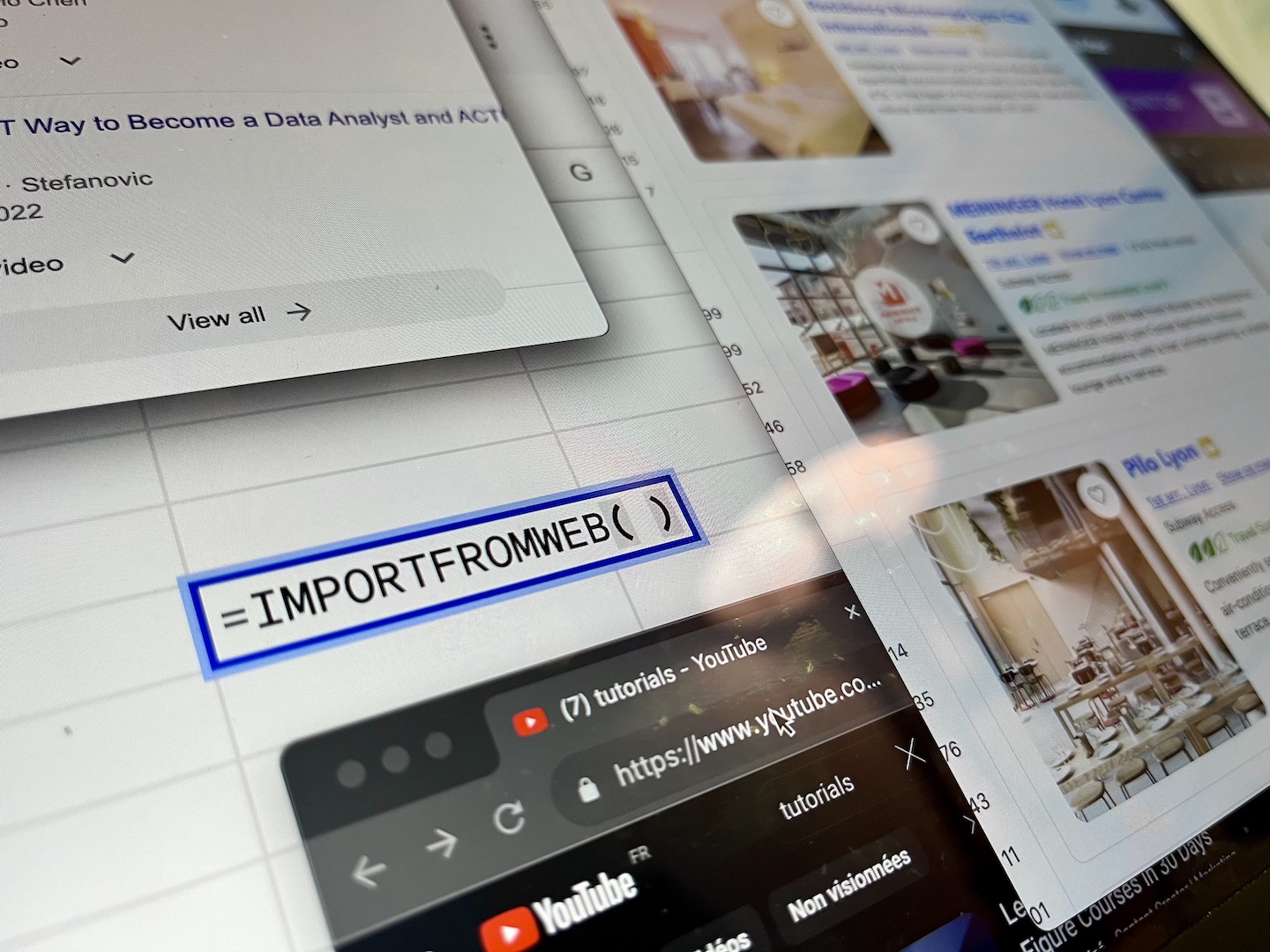
On Amazon, success as a seller depends on a multitude of factors. Among these, none is as crucial as understanding and analyzing competition. The ability to understand competitors’ strategies, get insights, and fine-tune your own approach can be the way to differentiate you from the competitors.
Competitor analysis isn’t an optional tactic; it’s the strategic path that holds every decision, from pricing strategies to catalog optimization and marketing approaches.
This comprehensive guide will give you the different steps to make a complete Amazon competitor analysis. More than theory, we delve into practical tools – with 5 free templates – designed to empower sellers to make their own strategies.
What is an Amazon competitor analysis?
Amazon is the largest retail platform, attracting intense competition. Having very good quality products isn’t enough; understanding competitors’ strategies is key to thriving in this competitive place.
And an Amazon competitor analysis isn’t just a routine exercise; it’s the meticulous process of identifying competitors first, and from there, analyzing their catalog, studying their pricing strategies and understanding their marketing tactics.
However, this may cost you significant time and effort to go through every possible competitors and products, collect and compile data manually, analyze it, and even more difficult to update it on a regular basis.
This is the reason why we wrote this guide: the aim is to provide you with essential knowledge and tools that drastically simplify the process, allowing you to bring to light the insights that you should be learning from your competitors more quickly.
Let’s see how to conduct an effective and not time-consuming Amazon competitive analysis!
Identifying your Competitors
A good Amazon competitor analysis lies on the ability to identify and categorize your competitors.
And it starts with conducting product research directly on Amazon. Initiate the process by using a broad keyword search to cast a wide net across the platform. On the search results page, take note of the top-ranking listings that stand out.

Identifying the competition is then as easy as clicking on the listings and search for the Store:

Keep searching new competitors as you gradually refine your search queries and keywords. This process leads you to a selected group of competitors that deserves your focused attention and detailed analysis.
Bear in mind that this process can be automated with an Amazon Search Scraper (see the template we introduced below)
The Key components to analyze from your competitors on Amazon
Now, let’s explore the essential steps that form the basis of effective Amazon competitor analysis.
1. The Catalog Analysis
We’ll see later how to access all the listings of your competitor with the Amazon Storefront Extractor. Let’s evaluate now the benefits of analysing those listings:
- Gap Identification: By analysing your competitors’ catalogs, you can identify areas where the market may have unmet needs. Identifying gaps in their product offerings allows you to strategically introduce complementary or differentiated products.
- Content Optimization: Analyze how competitors present their product listings. Assess their use of keywords, images, and product descriptions to optimize your own content and improve visibility in Amazon’s search algorithms.
- Best-Selling Product Recognition: Understanding the products that perform well for competitors provides valuable insights. It helps you focus on similar product categories, optimize listings, and potentially capture a share of the demand for those popular items.
2. The Pricing Strategy Analysis
- Competitive Positioning: Evaluate competitors’ pricing models to determine how your prices compare. Assess whether you want to position your products as premium, budget-friendly, or competitively priced in relation to similar offerings.
- Discount Strategies: Examine competitors’ discounting approaches, identifying patterns in when and how they offer discounts. This insight can inform your own discounting strategy to attract price-sensitive customers or capitalize on peak buying times.
- Pricing Fluctuations: Monitor competitors’ pricing fluctuations over time to anticipate market trends and adjust your pricing strategy accordingly.
To analyze prices in bulk, there’s no better tool than an Amazon Price Tracker.
3. The Marketing Strategy Assessment
- Sponsored Products Review: seek competitors’ use of sponsored products and other advertising features. Understand which products they prioritize for promotion. This knowledge can guide your own advertising investments.
- PPC Campaign Evaluation: Analyze competitors’ Pay-Per-Click (PPC) campaigns to understand the keywords they target. This information can help refine your own PPC strategy for optimal results.
- Promotional Strategies: Explore how competitors run promotions, such as limited-time offers, bundle deals, or loyalty programs. Understanding the effectiveness of these strategies allows you to fine-tune your own promotional efforts to attract and retain customers.
4. The Customer Reviews Analysis
To automate the process of collecting Amazon reviews, we recommend you to use an Amazon Reviews scraper.
- Sentiment Analysis: look at customer reviews to understand sentiments toward competitors’ products. Identify recurring positive themes and common concerns. This information can guide product improvements or highlight unique selling points.
- Strengths and Weaknesses Identification: Analyze customer feedback to identify competitors’ product strengths and weaknesses. Knowing where competitors are good/bad helps you refine your product offerings and marketing.
- Areas for Improvement: Pay attention to areas where competitors receive consistent feedback for improvement. Addressing these aspects in your own products can provide a competitive advantage and enhance customer satisfaction.
Now we know what makes a good Amazon Competitors analysis, from the identification of the competitors to the analysis of their product catalog and marketing strategies, we can delve into a set of 5 free templates tailored to automate and facilitate your analysis.
5 Free Templates for Amazon Competitor Analysis
These 5 templates combine the power of Google Sheets and the add-on ImportFromWeb. So as a prior step, make sure to install and activate the add-on from the Google Workspace marketplace.
ImportFromWeb is a tool that enables to extract Amazon data in Google Sheets. The process relies on a simple spreadsheet function – named =IMPORTFROMWEB() – that requires 2 parameters: the URL of the Amazon webpage to scrape and one or a list of data selectors. Executing the function outputs the data points requested in a single table with data ready to be crossed and manipulated.
1. Identify your competitors with the Amazon Search Scraper
With this template, you extract the listings that rank for a specific query in the Amazon search page, so you can easily identify your competitors.
You enter the query, select the Amazon store and input the number of search pages you want to scrape. ImportFromWeb draws a table with the ASINs that rank along with their name, price, rating, etc…
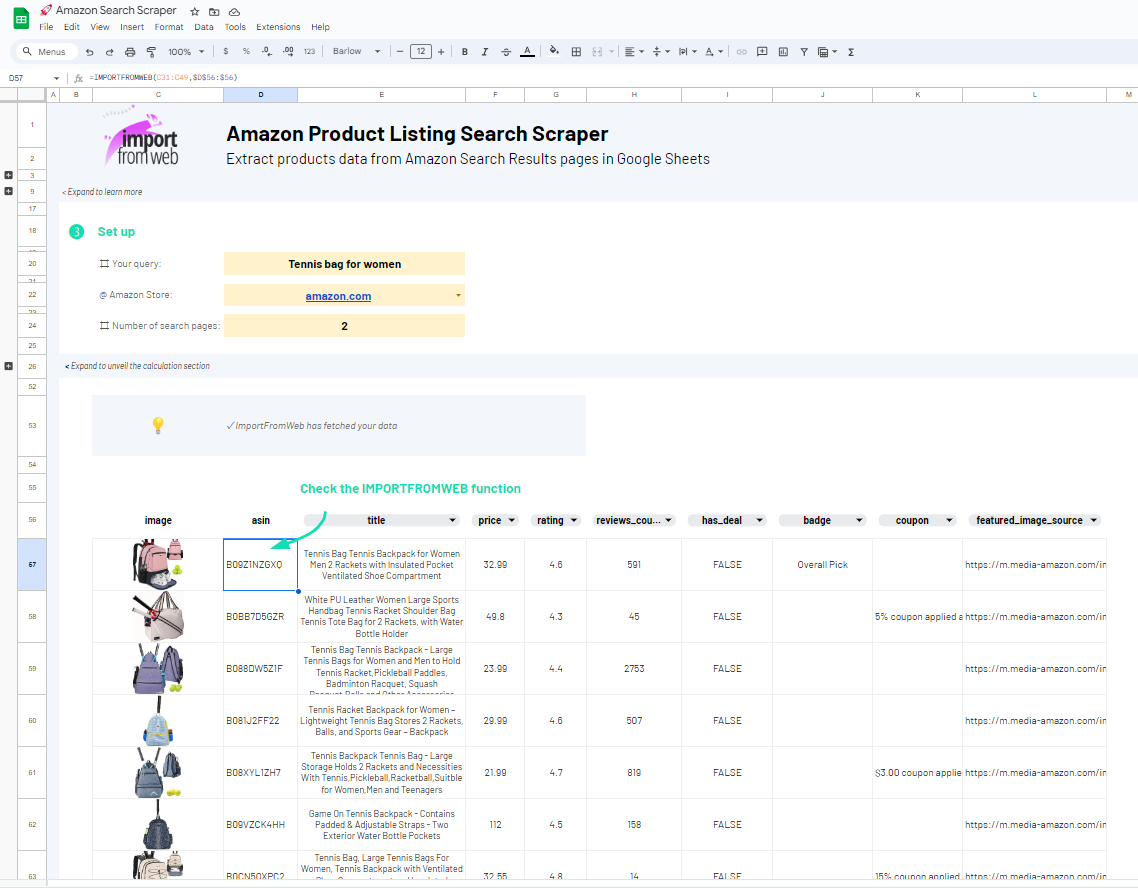
2. Extract your competitors’ Storefronts with the Amazon Storefront Extractor
With the Amazon Storefront Extractor, you get your competitor’s complete catalog for comparative analysis.
You enter your competitor’s storefront URL, input the number of pages you want to extract and select the desired selectors that will determine which data ImportFromWeb will output in your Google Sheets.
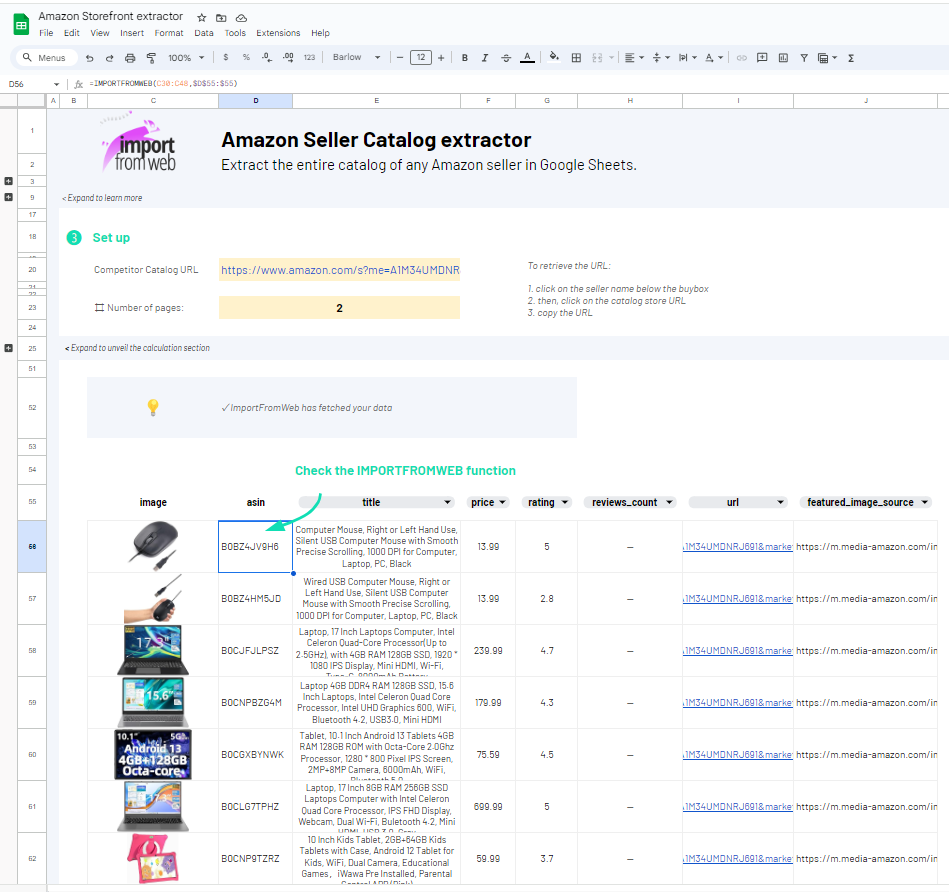
3. Analyze the listings of competition with the Amazon Product Scraper
With this template, you get a comprehensive data from competitor ASINs, including titles, descriptions, images, prices and key metrics for in-depth analysis (such as number of reviews, ratings and BSR)
From a list of ASINs you input, ImportFromWeb can output more than 60 data points!
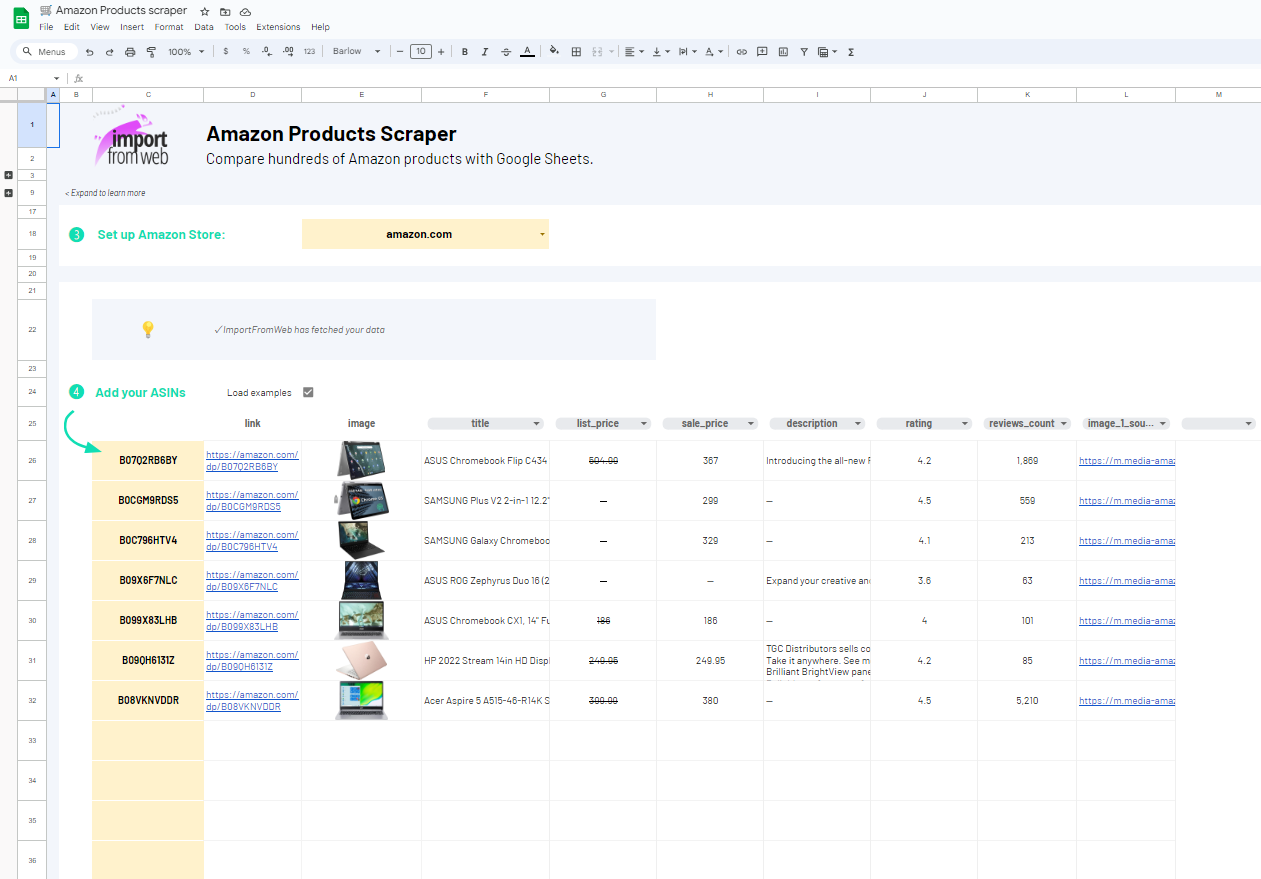
4. Understand your competitors pricing strategies with the Amazon Price Tracker
With the Amazon Price tracker, obtain real-time pricing data of competitors’ ASINs, including special offers for strategic pricing decisions.
As you can see on the screenshot below, you collect real time prices from a list of ASINs.
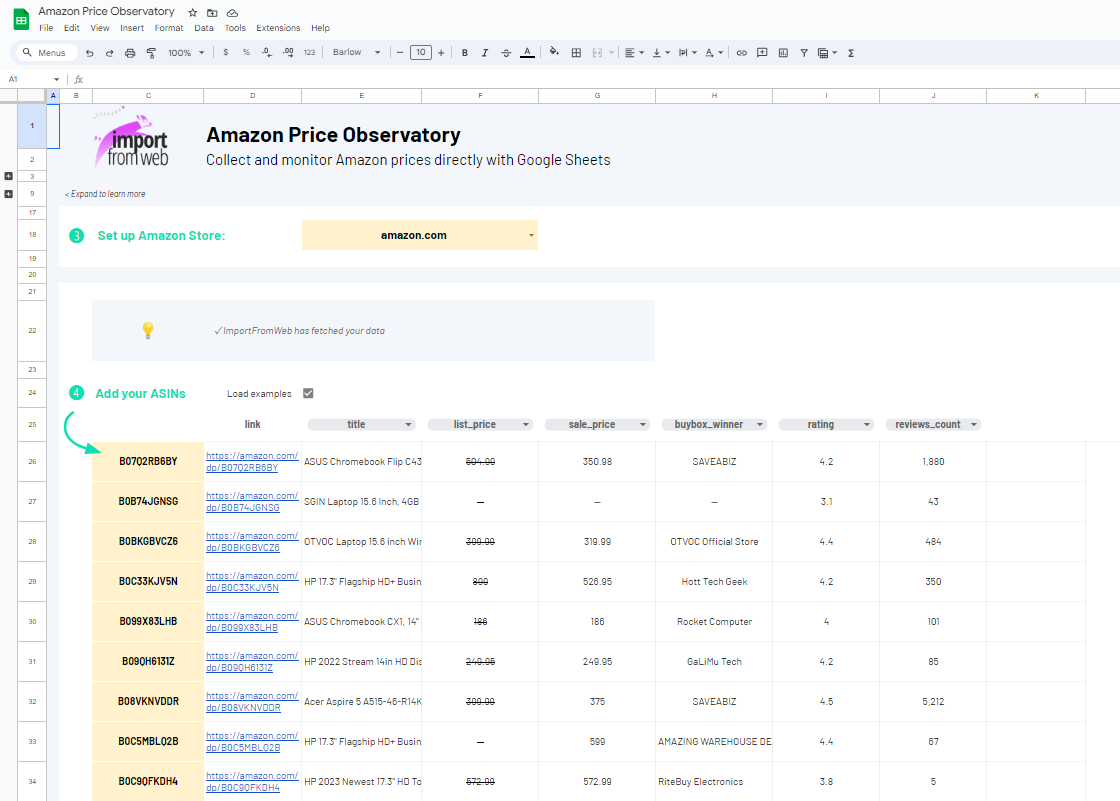
5. Delve into marketing tactics of competition with the Amazon Sponsored Ads Scraper
With the Amazon Sponsored Ads scraper, you effortlessly detect sponsored ASINs for any queries or keywords, enhancing understanding of competitors’ advertising strategies.
You enter your query and ImportFromWeb returns the list of sponsored products for that specific query.
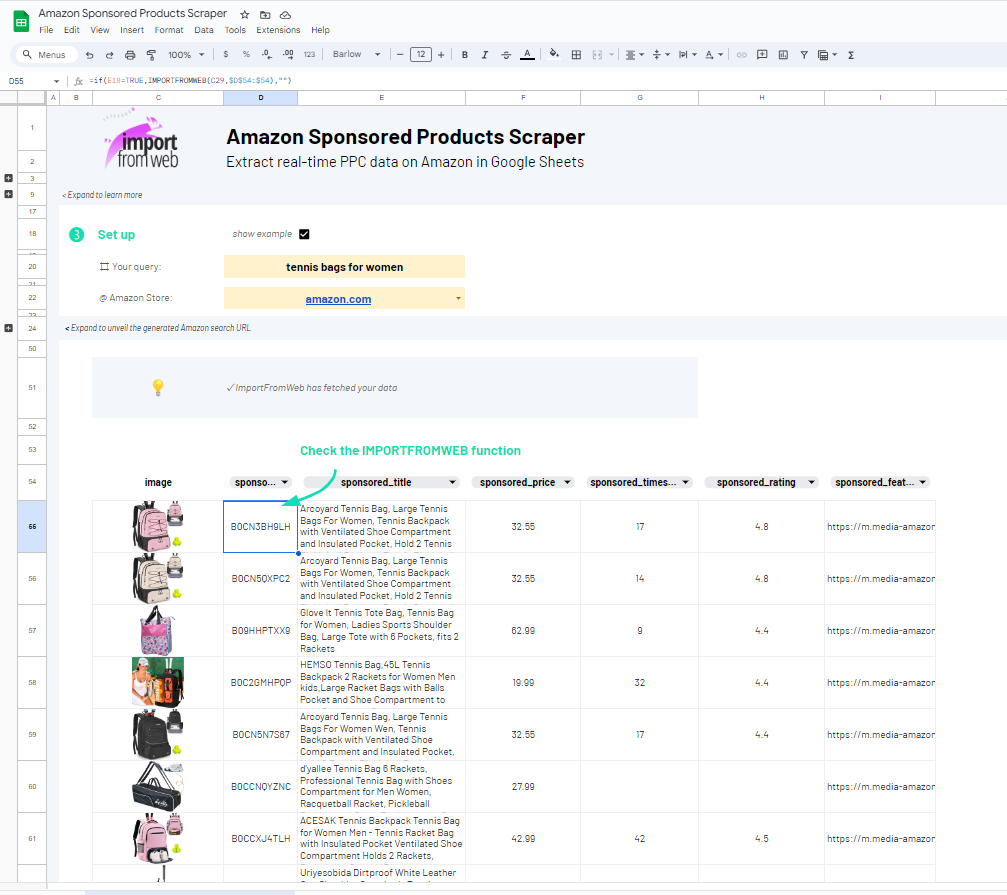
Using Google Sheets + ImportFromWeb for Amazon Competitor analysis offers several advantages and makes the process efficient and collaborative. Here are some reasons why it is interesting to leverage them for this purpose:
- Accessibility and Collaboration: User-Friendly, cloud-based collaboration, access anywhere, easy data import and integration.
- Automation and Customization: Built-in functions and formulas (including ImportFromWeb)
- Visualization and Reporting: Charts and graphs, conditional formatting
- Data Sharing: Shareable links, export options
Conclusion
Mastering the art of Amazon competitor analysis is crucial for success as a seller on this highly competitive platform. The process of identifying, analyzing, and staying ahead of competitors involves a deep dive into various data such as catalog offerings, pricing strategies, marketing tactics, and customer reviews.
To streamline this main aspect of Amazon selling, we’ve introduced a set of free Google Sheets templates equipped with the ImportFromWeb add-on.
These templates serve as invaluable tools, automating and facilitating the analysis process. From identifying competitors using the Amazon Search Scraper to accessing comprehensive catalog data with the Amazon Product Scraper, and delving into pricing strategies and marketing tactics with the Amazon Pricing Tool and Sponsored Ads Scraper, they are all designed to provide actionable insights.
The importance of integrating these templates into your Amazon selling strategy cannot be overstated. They offer accessibility, collaboration, automation, and customization, making the entire analysis more efficient and collaborative. By utilizing the power of Google Sheets and ImportFromWeb, sellers can gain a competitive edge by quickly and effectively extracting relevant data from Amazon, allowing for informed decision-making.

